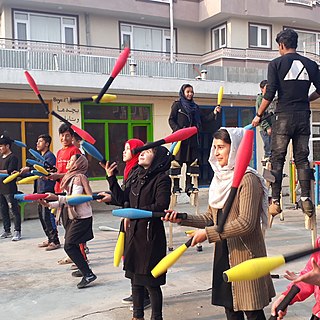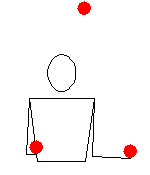
Juggling is a physical skill, performed by a juggler, involving the manipulation of objects for recreation, entertainment, art or sport. The most recognizable form of juggling is toss juggling. Juggling can be the manipulation of one object or many objects at the same time, most often using one or two hands but other body parts as well, like feet or head. Jugglers often refer to the objects they juggle as props. The most common props are balls, clubs, or rings. Some jugglers use more dramatic objects such as knives, fire torches or chainsaws. The term juggling can also commonly refer to other prop-based manipulation skills, such as diabolo, plate spinning, devil sticks, poi, cigar boxes, contact juggling, hooping, yo-yo, hat manipulation and kick-ups.

Fire performance is a group of performance arts or skills that involve the manipulation of fire. Fire performance typically involves equipment or other objects made with one or more wicks which are designed to sustain a large enough flame to create a visual effect.

Juggling clubs are a prop used by jugglers. Juggling clubs are often simply called clubs by jugglers and sometimes are referred to as pins or batons by non-jugglers. Clubs are one of the three most popular props used by jugglers; the others being balls and rings.

Passing is the act of juggling between two or more people. It is most commonly seen as a subset of toss juggling.

Toss juggling is the form of juggling which is most recognisable as 'juggling'. Toss juggling can be used as: a performing art, a sport, a form of exercise, as meditation, a recreational pursuit or hobby.

In toss juggling, the shower is a juggling pattern for 3 or more objects, most commonly balls or bean bags, where objects are thrown in a circular motion. Balls are thrown high from one hand to the other while the other hand passes the ball back horizontally. "In the shower pattern, every ball is thrown in a high arc from the right hand to the left and then quickly passed off with a low throw from the left to the right hand ." The animation depicts a 3-ball version. Siteswap notation for shower patterns is (2n-1)1, where n is the number of objects juggled. The circular motion of the balls is commonly represented in cartoons as the archetypical juggling pattern, somewhat at odds with reality, where the cascade is more common. By constantly reversing the direction, the box pattern can be formed.
Juggling practice has developed a wide range of patterns and forms which involve different types of manipulation, different props, numbers of props, and numbers of jugglers. The forms of juggling shown here are practiced by amateur, non-performing, hobby jugglers as well as by professional jugglers. The variations of juggling shown here are extensive but not exhaustive as juggling practice develops and creates new patterns on a regular basis. Jugglers do not consciously isolate their juggling into one of the categories shown; instead most jugglers will practice two or more forms, combining the varieties of juggling practice. Some forms are commonly mixed, for example: numbers and patterns with balls; while others are rarely mixed, for example: contact numbers passing. Many Western jugglers also practice other forms of object manipulation, such as diabolo, devil sticks, cigar box manipulation, fire-spinning, contact juggling, hat manipulation, poi, staff-spinning, balancing tricks, bar flair and general circus skills.

Poi is a performing art and also the name of the equipment used for its performance. As a skill toy, poi is an object or theatrical prop used for dexterity play or an object manipulation. As a performance art, poi involves swinging tethered weights through a variety of rhythmical and geometric patterns. Poi artists may also sing or dance while swinging their poi. Poi can be made from various materials with different handles, weights, and effects.
Michael Moschen is an American juggler.

Hat manipulation is a form of juggling in which the manipulator performs feats of skill and dexterity using a brimmed hat such as a bowler hat or a top hat as a prop. Tricks can range from rolling a hat up and down the various parts of the body to throwing and catching the hat in amusing ways. Hat manipulation is often comedic in nature. Part of the appeal of the art is in the necessary equipment; all that is needed is a good, heavy, brimmed hat, which can be found at many juggling stores. Famous manufacturers of manipulation specific hats are Nils Poll and Dubé. Hat manipulation is also frequently combined with traditional forms of juggling in order to create more varied acts.
In contact juggling, poi spinning, hooping and other types of object manipulation, an isolation is an illusion whereby a prop appears to float in space, with the performer's hands and body moving around it. In reality, the performer is supporting the prop, and countering his or her movement relative to the prop.

Enrico Rastelli was an Italian juggler, acrobat, and performer.

Twirling is a form of object manipulation where an object is twirled by one or two hands, the fingers or by other parts of the body. Twirling practice manipulates the object in circular or near circular patterns. It can also be done indirectly by the use of another object or objects as in the case of devil stick manipulation where handsticks are used. Twirling is performed as a hobby, sport, exercise or performance.

Juggling balls, or simply balls, are a popular prop used by jugglers, either on their own—usually in sets of three or more—or in combination with other props such as clubs or rings. A juggling ball refers to any juggling object that is roughly spherical in nature.
Object manipulation is a form of dexterity play or performance in which one or more people physically interact with one or more objects. Many object manipulation skills are recognised circus skills. Other object manipulation skills are linked to sport, magic, and everyday objects or practices. Many object manipulation skills use special props made for that purpose: examples include the varied circus props such as balls, clubs, hoops, rings, poi, staff, and devil sticks; magic props such as cards and coins; sports equipment such as nunchaku and footballs. Many other objects can also be used for manipulation skills. Object manipulation with ordinary items may be considered to be object manipulation when the object is used in an unusually stylised or skilful way or for a physical interaction outside of its socially acknowledged context or differently from its original purpose.
A juggling robot is a robot designed to be able to successfully carry out bounce or toss juggling. Robots capable of juggling are designed and built both to increase and test understanding and theories of human movement, juggling, and robotics. Juggling robots may include sensors to guide arm/hand movement or may rely on physical methods such as tracks or funnels to guide prop movement. Since true juggling requires more props than hands, many robots described as capable of juggling are not.
Juggling terminology, juggling terms:













